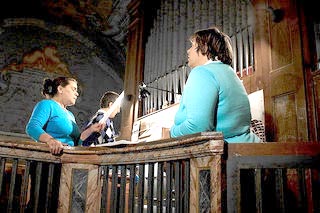The Beauty and Creativity of Small Church Worship
 Our Ambassadors have visited 43 churches in the last 18 months or so. We’ve been to large churches and small. We’ve heard 15-member choirs with paid section leaders and small churches with small choirs and solo musicians.
Our Ambassadors have visited 43 churches in the last 18 months or so. We’ve been to large churches and small. We’ve heard 15-member choirs with paid section leaders and small churches with small choirs and solo musicians.
The worship experience isn’t fashioned to compete, but our Ambassadors can’t help but observe. There is a big difference in the worship experience in a church with more than 50 in attendance and the many smaller churches we visit.
We have found some of the most creative and enriching worship experiences in congregations with less than 30 in attendance. Our last two visits were prime examples.
Tabernacle Lutheran Church in West Philadelphia has a great pianist who led a breadth of musical selections throughout a two-hour service. He was in sync with the pastor and the choir and shifted seamlessly from liturgy to Gospel music and hymns to anthems with additional meditative offerings. Except for the quality of his work, you might not be aware of his presence, it so complemented the worship experience. A third of the worshiping body was robed and singing in the choir. The congregation was actively involved, often singing along with the choir. Members of the congregation rose to offer lengthy prayer petitions. The service was an expression of the people in every way.
St. John’s in Ambler also had a wealth of music throughout the service, led by a small combo of flute, piano/cello, organ and a cantor. Sections of the liturgy were sewn together by musical interludes that were frequent and beautiful, diverse and appropriate. Worship was not rushed but evolved at a pace that the entire congregation seemed to find comfortable. By the end of the service, half the congregation had taken part in worship leadership.
In several small churches, lay members even filled the pulpit. At. St. Mark’s, Conshohocken, a school teacher read her own meditation. At. St. Michael’s, Kensington, a lay leader read a sermon prepared by the pastor but delivered with her own passion. She deftly addressed the children in a hands-on children’s sermon.
In our experience, congregational singing excelled in smaller churches. In larger churches, the collective voice of the people was often drowned out by organ power. (Organs were installed and designed with full sanctuaries in mind — rarely the case today!)
Larger churches often featured the standard three/four hymns and an anthem with appreciative congregations that were comfortable with a structure that asked little of them.
Why does the small church worship experience often stand out?
Small numbers may make it necessary for churches to nurture skills that might be hidden in larger churches, where paid talent makes the worship choices.
The small church worship experience is owned by the congregation. The members of small churches are accustomed to stepping forward to provide leadership. Such initiative might be impossible in large congregations.
This is a joy of small church ministry. Everyone can grow. The experience is the responsibility of the people. The result is spiritual growth. There is growth in other ways, too. The congregation becomes tolerant of the imperfect, forgiving of miscues, and encouraging to the early efforts of the timid. Worshipers begin to recognize their fellow worshipers in a broader dimension, experiencing their offerings of expression.
Perhaps, what the Church needs is more SMALL churches and a way to better plan to make their good work known!
